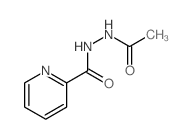CHEMICAL IDENTIFICATION
-
RTECS NUMBER :
-
MU7700000
-
CHEMICAL NAME :
-
Hydrazine, 1-acetyl-2-picolinoyl-
-
CAS REGISTRY NUMBER :
-
17433-31-7
-
LAST UPDATED :
-
199612
-
DATA ITEMS CITED :
-
10
-
MOLECULAR FORMULA :
-
C8-H9-N3-O2
-
MOLECULAR WEIGHT :
-
179.20
-
WISWESSER LINE NOTATION :
-
T6NJ BVMMV1
HEALTH HAZARD DATA
ACUTE TOXICITY DATA
-
TYPE OF TEST :
-
LD50 - Lethal dose, 50 percent kill
-
ROUTE OF EXPOSURE :
-
Oral
-
SPECIES OBSERVED :
-
Rodent - rat
-
DOSE/DURATION :
-
673 mg/kg
-
TOXIC EFFECTS :
-
Behavioral - somnolence (general depressed activity) Gastrointestinal - changes in structure or function of salivary glands Gastrointestinal - nausea or vomiting
-
REFERENCE :
-
NCICP* Progress Report Submitted to the National Cancer Institute by Charles Pfizer & Co. Volume(issue)/page/year: -,169,1965
-
TYPE OF TEST :
-
LD50 - Lethal dose, 50 percent kill
-
ROUTE OF EXPOSURE :
-
Intravenous
-
SPECIES OBSERVED :
-
Rodent - rat
-
DOSE/DURATION :
-
470 mg/kg
-
TOXIC EFFECTS :
-
Behavioral - somnolence (general depressed activity) Behavioral - muscle weakness
-
REFERENCE :
-
NCICP* Progress Report Submitted to the National Cancer Institute by Charles Pfizer & Co. Volume(issue)/page/year: -,169,1965
-
TYPE OF TEST :
-
LD50 - Lethal dose, 50 percent kill
-
ROUTE OF EXPOSURE :
-
Oral
-
SPECIES OBSERVED :
-
Rodent - mouse
-
DOSE/DURATION :
-
410 mg/kg
-
TOXIC EFFECTS :
-
Behavioral - convulsions or effect on seizure threshold
-
REFERENCE :
-
NCICP* Progress Report Submitted to the National Cancer Institute by Charles Pfizer & Co. Volume(issue)/page/year: -,169,1965
-
TYPE OF TEST :
-
LD50 - Lethal dose, 50 percent kill
-
ROUTE OF EXPOSURE :
-
Intravenous
-
SPECIES OBSERVED :
-
Rodent - mouse
-
DOSE/DURATION :
-
255 mg/kg
-
TOXIC EFFECTS :
-
Details of toxic effects not reported other than lethal dose value
-
REFERENCE :
-
NCICP* Progress Report Submitted to the National Cancer Institute by Charles Pfizer & Co. Volume(issue)/page/year: -,169,1965
-
TYPE OF TEST :
-
LDLo - Lowest published lethal dose
-
ROUTE OF EXPOSURE :
-
Intravenous
-
SPECIES OBSERVED :
-
Mammal - dog
-
DOSE/DURATION :
-
100 mg/kg
-
TOXIC EFFECTS :
-
Behavioral - somnolence (general depressed activity) Behavioral - convulsions or effect on seizure threshold Gastrointestinal - nausea or vomiting
-
REFERENCE :
-
NCICP* Progress Report Submitted to the National Cancer Institute by Charles Pfizer & Co. Volume(issue)/page/year: -,169,1965 ** OTHER MULTIPLE DOSE TOXICITY DATA **
-
TYPE OF TEST :
-
TDLo - Lowest published toxic dose
-
ROUTE OF EXPOSURE :
-
Parenteral
-
SPECIES OBSERVED :
-
Mammal - dog
-
DOSE/DURATION :
-
576 mg/kg/24D-I
-
TOXIC EFFECTS :
-
Behavioral - food intake (animal) Gastrointestinal - nausea or vomiting Endocrine - other changes
-
REFERENCE :
-
NCICP* Progress Report Submitted to the National Cancer Institute by Charles Pfizer & Co. Volume(issue)/page/year: -,169,1965
-
TYPE OF TEST :
-
TDLo - Lowest published toxic dose
-
ROUTE OF EXPOSURE :
-
Parenteral
-
SPECIES OBSERVED :
-
Primate - monkey
-
DOSE/DURATION :
-
1152 mg/kg/24D-I
-
TOXIC EFFECTS :
-
Behavioral - food intake (animal) Gastrointestinal - nausea or vomiting Kidney, Ureter, Bladder - proteinuria
-
REFERENCE :
-
NCICP* Progress Report Submitted to the National Cancer Institute by Charles Pfizer & Co. Volume(issue)/page/year: -,169,1965 ** TUMORIGENIC DATA **
-
TYPE OF TEST :
-
TDLo - Lowest published toxic dose
-
ROUTE OF EXPOSURE :
-
Intraperitoneal
-
SPECIES OBSERVED :
-
Rodent - rat
-
DOSE/DURATION :
-
9750 mg/kg/26W-I
-
TOXIC EFFECTS :
-
Tumorigenic - neoplastic by RTECS criteria Gastrointestinal - tumors
-
REFERENCE :
-
RRCRBU Recent Results in Cancer Research. (Springer-Verlag New York, Inc., Service Center, 44 Hartz Way, Secaucus, NJ 07094) V.1- 1965- Volume(issue)/page/year: 52,1,1975
-
TYPE OF TEST :
-
TDLo - Lowest published toxic dose
-
ROUTE OF EXPOSURE :
-
Intraperitoneal
-
SPECIES OBSERVED :
-
Rodent - mouse
-
DOSE/DURATION :
-
9750 mg/kg/26W-I
-
TOXIC EFFECTS :
-
Tumorigenic - neoplastic by RTECS criteria Lungs, Thorax, or Respiration - tumors Reproductive - Tumorigenic effects - ovarian tumors
-
REFERENCE :
-
RRCRBU Recent Results in Cancer Research. (Springer-Verlag New York, Inc., Service Center, 44 Hartz Way, Secaucus, NJ 07094) V.1- 1965- Volume(issue)/page/year: 52,1,1975
|
